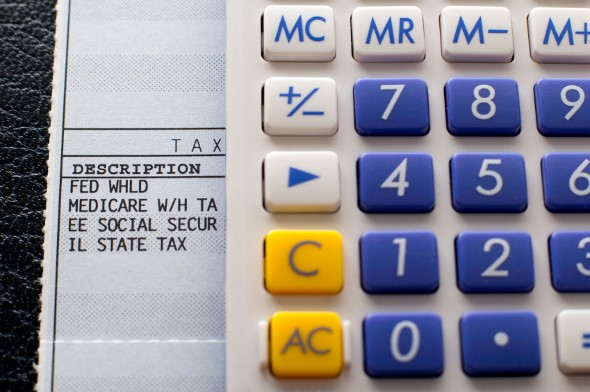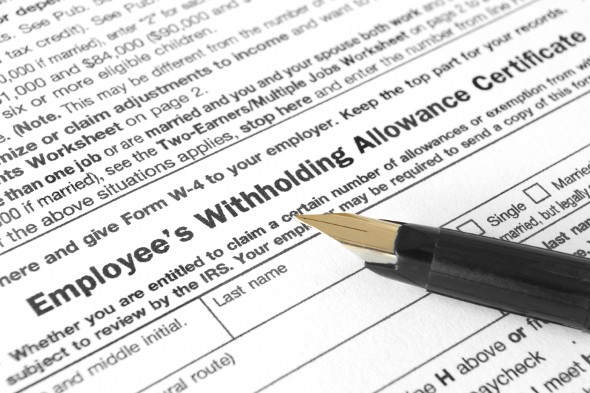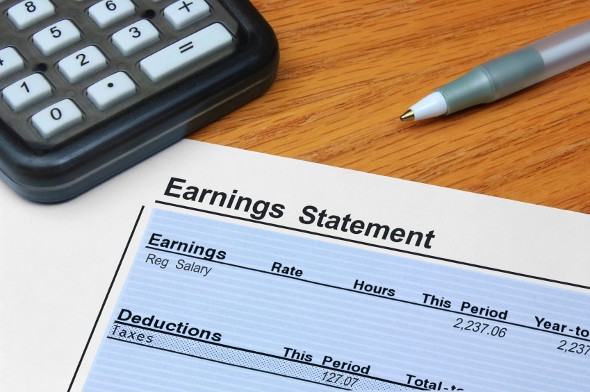
According to the U.S. Department of the Treasury, payroll taxes made up approximately 36% of all federal revenue generated in fiscal year 2023. That’s $1.61 trillion out of $4.44 trillion. These taxes come from the wages, salaries, and tips that are paid to employees, and the government uses them to finance Social Security and Medicare. Employers withhold payroll tax on behalf of their employees and pay it directly to the government. If you take a close look at your earnings statement, you’ll see that payroll taxes take a serious bite out your paycheck. But a financial advisor can look at your tax situation and help you reach your financial goals.
Need help estimating how much you’ll owe in taxes this year? Check out our income tax calculator.
Payroll Tax Definition
Payroll taxes are part of the reason your take-home pay is different from your salary. If your health insurance premiums and retirement savings are deducted from your paycheck automatically, those deductions (combined with payroll taxes) can result in paychecks well below what you would get otherwise. When you start a new job and fill out a W-4 tax withholding form, your employer starts deducting state and federal payroll taxes from your earnings to pay for Social Security and Medicare.
Social Security taxes began in 1937, at a modest rate of 2%. Medicare hospital insurance taxes didn’t kick in until 1966, at a rate of 0.7%. Rates have climbed since then, of course, with the rate increase for Social Security taxes outpacing the rise in Medicare hospital insurance taxes.
In 2024, Social Security taxes only apply to the first $168,200 of income, which is an increase from 2023 when they applied to the first $160,200. The income cap on payroll taxes has led some to criticize the payroll tax. Those who want to reform the payroll tax call it a regressive tax – one that doesn’t require the rich to pay more.
In tough economic times like the Great Recession, Congress cuts payroll taxes to give Americans a little extra take-home pay. More recently, President Trump allowed employers to temporarily suspend withholding and paying payroll taxes to offer COVID-19 relief. When cuts like these expire, it can reignite the debate over how payroll taxes work.
Related Article: Tax Prep Checklist
Employer Payroll Tax

Employers pay a share of some payroll taxes for their employees. That’s why if you go from being an employee of someone else to being self-employed your payroll tax liability will double. It’s something to budget for if you’re thinking of making the jump to self-employment.
Before 1989, the tax rate for self-employed people was less than the combined tax rate on employers and employees. Those days are over, though. The IRS recently announced that it will be cracking down on employers who don’t collect enough money in payroll taxes. If you’re a business owner, take note.
Under the umbrella term “payroll taxes,” employers are required to withhold state and federal income taxes from their employees’ earnings, as well as Social Security and Medicare taxes. These last two taxes are known as FICA taxes, after the Federal Insurance Contributions Act. Federal payroll taxes are consistent across states, while state payroll taxes vary according to the income tax rates in each state.
The employer is playing the role of an agent for the government, collecting taxes from employees and remitting them to the state and federal government. However, the matching share of FICA taxes that the employer pays is considered a business expense, not a liability. Because it’s a business expense it can be written off at tax time.
Related Article: The Lowest Taxes in America
Payroll Tax Rates

The current tax rate for Social Security is 6.2% for the employer and 6.2% for the employee, for a total of 12.4%. The current rate for Medicare is 1.45% for the employer and 1.45% for the employee, for a total of 2.9%. That means that combined FICA tax rates for 2024 and 2023 are 7.65% for employers and 7.65% for employees, bringing the total to 15.3%.
A recent report from the Congressional Budget Office suggests that raising Social Security payroll taxes is necessary to extend the solvency of the Social Security trust funds. As discussed, raising the maximum taxable income might be a complement or an alternative to raising payroll tax rates.
Since 2013, high-income folks have had to pay a little extra in Medicare payroll taxes under a provision of the Affordable Care Act. This “Additional Medicare Tax” adds 0.9% to the employee-paid portion of payroll taxes above a certain income threshold.
For single filers, that threshold is $200,000. For married couples filing jointly the income threshold is $250,000. Married filing separately? Your income threshold is $125,000. Say you’re a single filer. The first $200,000 of your salary will be subject to the regular 1.45% employee-paid Medicare tax. Every dollar above $200,000 will then be taxed at 2.35% (1.45+0.9=2.35).
Bottom Line
Payroll taxes reduce your take-home pay. But since they are deducted from your earnings, you won’t have to pay a huge tax bill once a year. This can make it easier to manage your money and it may even get you a refund come tax time. That is why it’s important to fill out your W-4 tax withholding form correctly when you start a new job and update it as needed since this determines how much your employer withholds from your paycheck.
Tax Planning Tips
- A financial advisor with tax expertise can be a valuable resource when it comes to managing your taxes. Finding a financial advisor doesn’t have to be hard. SmartAsset’s free tool matches you with up to three vetted financial advisors who serve your area, and you can have a free introductory call with your advisor matches to decide which one you feel is right for you. If you’re ready to find an advisor who can help you achieve your financial goals, get started now.
- There are many ways to lower your taxes. A financial advisor can help you find the best strategy for your financial goals and needs. If you are self-employed, an advisor can help you avoid employment taxes by structuring your business to pay you in dividends instead of a salary.
- If you’re freelancing on the side, you’ll need to pay taxes on that extra income. You can pay estimated taxes quarterly or get more taxes withheld from your paycheck. The SmartAsset federal income tax calculator can help you figure out how much to withhold. (You’ll need a pay stub to see how much you are paying in taxes and how much more you owe.)
Photo credit: © iStock/Ahlapot, © iStock/i_frontier, © iStock/GaryPhoto